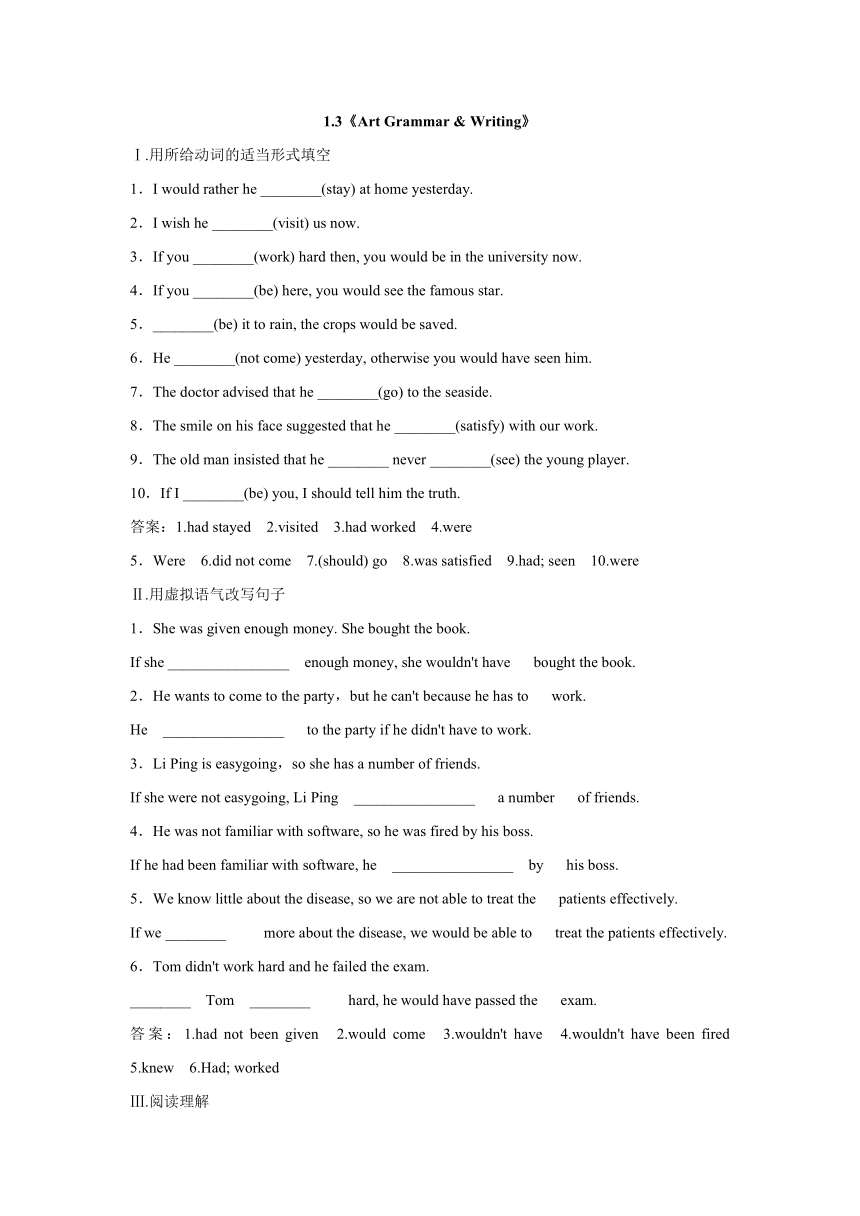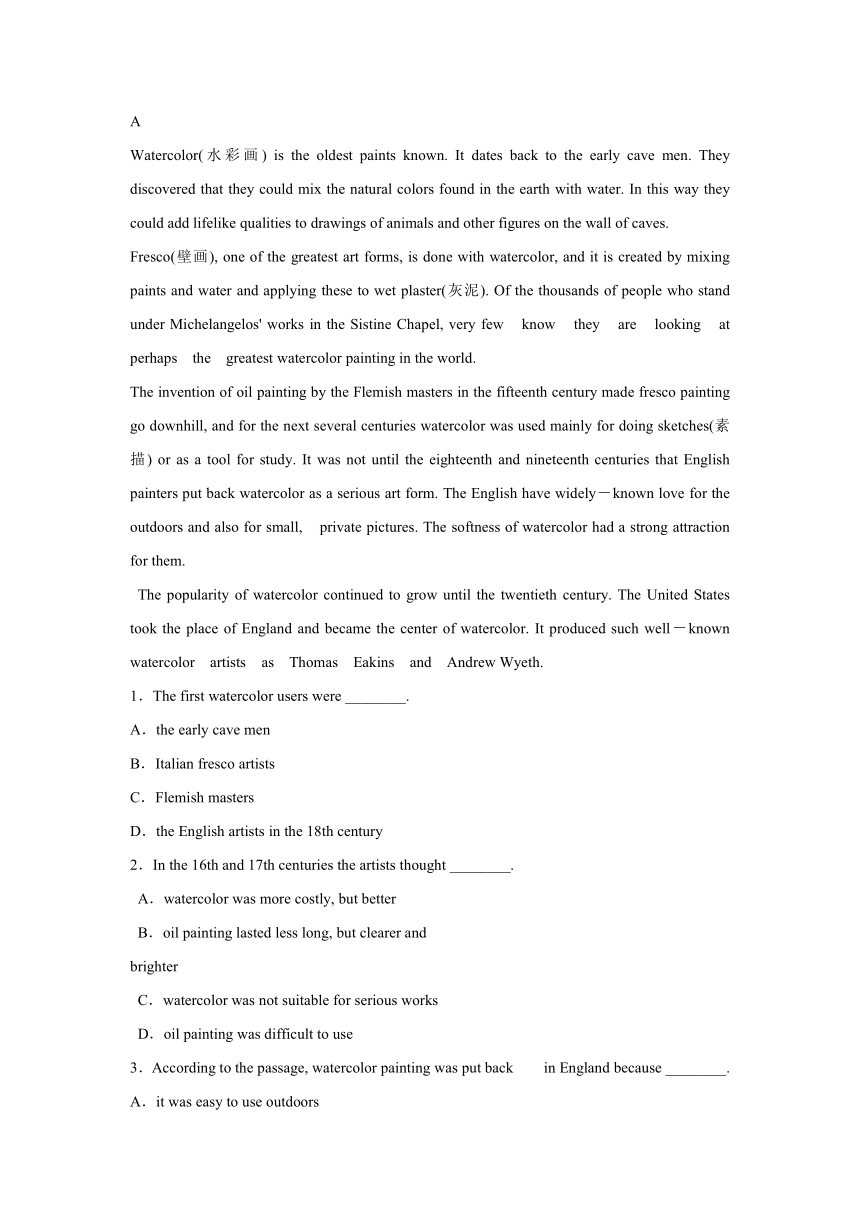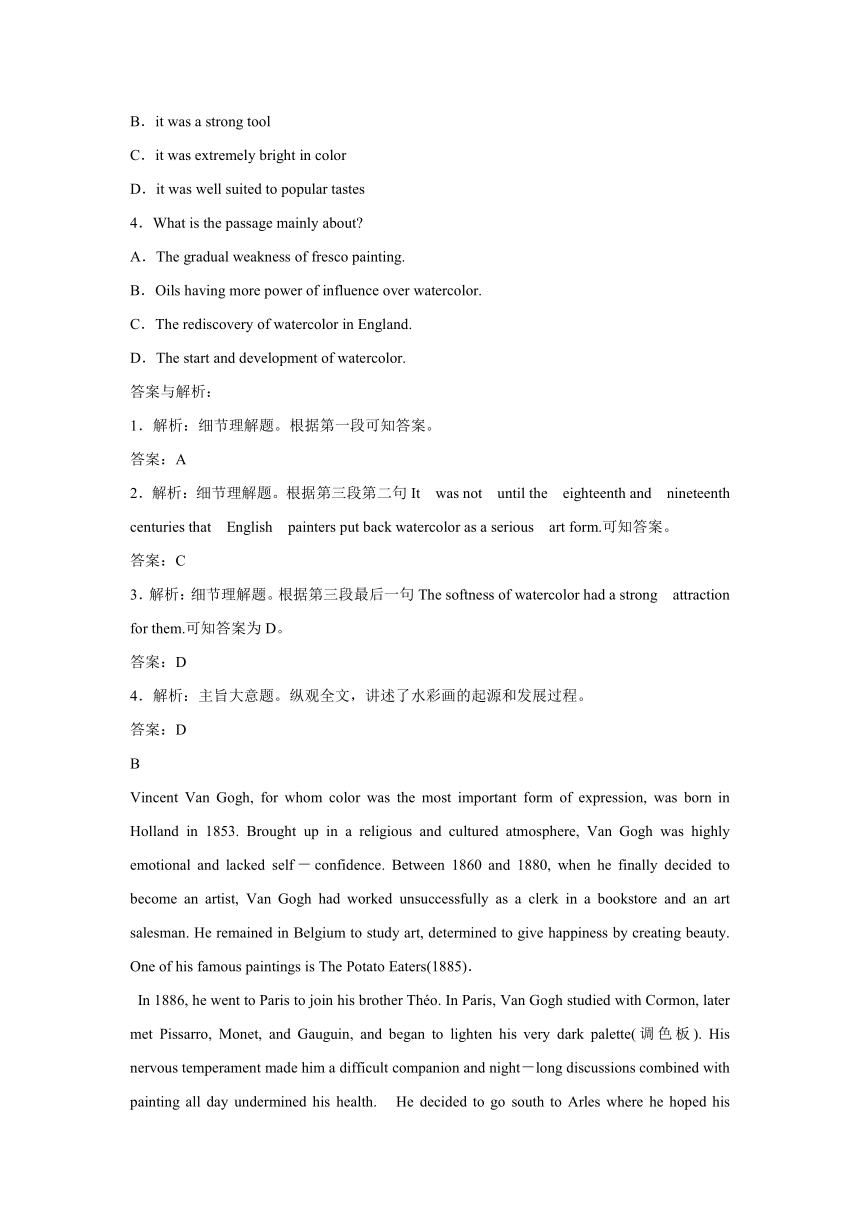2015-2016学年高中英语 1.3《Art Grammar & Writing》练习(含部分答案解析)
文档属性
| 名称 | 2015-2016学年高中英语 1.3《Art Grammar & Writing》练习(含部分答案解析) |  | |
| 格式 | zip | ||
| 文件大小 | 16.0KB | ||
| 资源类型 | 教案 | ||
| 版本资源 | 人教版(新课程标准) | ||
| 科目 | 英语 | ||
| 更新时间 | 2016-04-20 11:25:41 | ||
图片预览



文档简介
1.3《Art Grammar & Writing》
Ⅰ.用所给动词的适当形式填空
1.I would rather he ________(stay) at home yesterday.
2.I wish he ________(visit) us now.
3.If you ________(work) hard then, you would be in the university now.
4.If you ________(be) here, you would see the famous star.
5.________(be) it to rain, the crops would be saved.
6.He ________(not come) yesterday, otherwise you would have seen him.
7.The doctor advised that he ________(go) to the seaside.
8.The smile on his face suggested that he ________(satisfy) with our work.
9.The old man insisted that he ________ never ________(see) the young player.
10.If I ________(be) you, I should tell him the truth.
答案:1.had stayed 2.visited 3.had worked 4.were
5.Were 6.did not come 7.(should) go 8.was satisfied 9.had; seen 10.were
Ⅱ.用虚拟语气改写句子
1.She was given enough money. She bought the book.
If she ________________ enough money, she wouldn't have bought the book.
2.He wants to come to the party,but he can't because he has to work.
He ________________ to the party if he didn't have to work.
3.Li Ping is easygoing,so she has a number of friends.
If she were not easygoing, Li Ping ________________ a number of friends.
4.He was not familiar with software, so he was fired by his boss.
If he had been familiar with software, he ________________ by his boss.
5.We know little about the disease, so we are not able to treat the patients effectively.
If we ________ more about the disease, we would be able to treat the patients effectively.
6.Tom didn't work hard and he failed the exam.
________ Tom ________ hard, he would have passed the exam.
答案:1.had not been given 2.would come 3.wouldn't have 4.wouldn't have been fired 5.knew 6.Had; worked
Ⅲ.阅读理解
A
Watercolor(水彩画) is the oldest paints known. It dates back to the early cave men. They discovered that they could mix the natural colors found in the earth with water. In this way they could add lifelike qualities to drawings of animals and other figures on the wall of caves.
Fresco(壁画), one of the greatest art forms, is done with watercolor, and it is created by mixing paints and water and applying these to wet plaster(灰泥). Of the thousands of people who stand under Michelangelos' works in the Sistine Chapel, very few know they are looking at perhaps the greatest watercolor painting in the world.
The invention of oil painting by the Flemish masters in the fifteenth century made fresco painting go downhill, and for the next several centuries watercolor was used mainly for doing sketches(素描) or as a tool for study. It was not until the eighteenth and nineteenth centuries that English painters put back watercolor as a serious art form. The English have widely-known love for the outdoors and also for small, private pictures. The softness of watercolor had a strong attraction for them.
The popularity of watercolor continued to grow until the twentieth century. The United States took the place of England and became the center of watercolor. It produced such well-known watercolor artists as Thomas Eakins and Andrew Wyeth.
1.The first watercolor users were ________.
A.the early cave men
B.Italian fresco artists
C.Flemish masters
D.the English artists in the 18th century
2.In the 16th and 17th centuries the artists thought ________.
A.watercolor was more costly, but better
B.oil painting lasted less long, but clearer and
brighter
C.watercolor was not suitable for serious works
D.oil painting was difficult to use
3.According to the passage, watercolor painting was put back in England because ________.
A.it was easy to use outdoors
B.it was a strong tool
C.it was extremely bright in color
D.it was well suited to popular tastes
4.What is the passage mainly about
A.The gradual weakness of fresco painting.
B.Oils having more power of influence over watercolor.
C.The rediscovery of watercolor in England.
D.The start and development of watercolor.
答案与解析:
1.解析:细节理解题。根据第一段可知答案。
答案:A
2.解析:细节理解题。根据第三段第二句It was not until the eighteenth and nineteenth centuries that English painters put back watercolor as a serious art form.可知答案。
答案:C
3.解析:细节理解题。根据第三段最后一句The softness of watercolor had a strong attraction for them.可知答案为D。
答案:D
4.解析:主旨大意题。纵观全文,讲述了水彩画的起源和发展过程。
答案:D
B
Vincent Van Gogh, for whom color was the most important form of expression, was born in Holland in 1853. Brought up in a religious and cultured atmosphere, Van Gogh was highly emotional and lacked self-confidence. Between 1860 and 1880, when he finally decided to become an artist, Van Gogh had worked unsuccessfully as a clerk in a bookstore and an art salesman. He remained in Belgium to study art, determined to give happiness by creating beauty. One of his famous paintings is The Potato Eaters(1885).
In 1886, he went to Paris to join his brother Théo. In Paris, Van Gogh studied with Cormon, later met Pissarro, Monet, and Gauguin, and began to lighten his very dark palette(调色板). His nervous temperament made him a difficult companion and night-long discussions combined with painting all day undermined his health. He decided to go south to Arles where he hoped his friends would join him and help found a school of art. Gauguin did join him but with bad results. Near the end of 1888, an incident led Gauguin to finally leave Arles. Van Gogh ran after him with an open razor, was stopped by Gauguin, but ended up cutting a part of his own ear off. Van Gogh then was sent to a mental (精神的) hospital for treatment.
In May of 1890, he seemed much better and went to live in Auvers-sur-Oise under the watchful eye of Dr. Gachet. Two months later he was dead, having shot himself “for the good of all”. During his brief career he had sold one painting. Van Gogh's finest works were produced in less than three years. His great fusion(融合) of form and content is powerful, dramatic and emotional, for the artist was completely absorbed in the effort to explain either his struggle against madness or his comprehension of the spiritual essence(精华) of man and nature.
5.Which of the following best helped Van Gogh to express himself in his works
A.Language. B.Color.
C.Letters. D.Words.
6.Before Van Gogh started to learn art, ________.
A.he couldn't do his work well
B.he was confident about himself
C.he did a good job in a bookstore
D.he was one of the successful artists
7.The underlined word “undermined” in Paragraph 2 means ________.
A.harmed B.improved
C.challenged D.punished
8.Gauguin finally decided to leave Van Gogh probably because ________.
A.Van Gogh didn't like Gauguin at all
B.something was wrong with Van Gogh
C.Gauguin cut off one of Van Gogh's ears
D.Gauguin hated to be a teacher at the school
9.What can we learn from Van Gogh's works
A.His pride and kindness.
B.His cruelty and failure.
C.His honesty and strength.
D.His struggle and viewpoints.
答案与解析:
5.解析:细节理解题。根据第一段第一句可知,对Van Gogh来说,色彩是他表达自己的最重要途径,故选B项。
答案:B
6.解析:细节理解题。根据第一段第三句可知,在Van Gogh决定成为画家之前,他的工作并不成功,也就是没能把自己的工作做好。
答案:A
7.解析:词义猜测题。彻夜长谈及整日画画对健康不利,画线词意为“损害”,harm与其意思接近。
答案:A
8.解析:推理判断题。根据第二段最后三句可推知,Van Gogh精神上出现了问题,他想伤害Gauguin,所以Gauguin选择了离开。
答案:B
9.解析:细节理解题。根据文章最后一句可知,Van Gogh在他的作品中展现了他与精神错乱的抗争及他对人与自然的精神实质的理解,故D项正确。
答案:D
Ⅳ.短文改错
On a cold winter night, it was snowing heavily, a bus with 45 passenger had an accident because of the wet road. And all of them were trapping in the bus and what was worse,the bus ran out of gas and it is very cold in it. They could do nothing but to wait for help. A man who lived nearby saw what happened. He and some villagers managed to open the door and helped all of them out of bus. He took them to his home but offered food and water and even some warm clothes to the children. They spent two days in their home and finally helps came. All of them were thankful with their help.
答案:
On a cold winter night, it was snowing heavily, a bus with 45 had an accident because of the wet road. And all of them were in the bus and what was worse,the bus ran out of gas and it very cold in it. They could do nothing but wait for help. A man who lived nearby saw what happened. He and some villagers managed to open the door and helped all of them out of bus. He took them to his home offered food and water and even some warm clothes to the children. They spent two days in home and finally came. All of them were thankful their help.
Ⅰ.用所给动词的适当形式填空
1.I would rather he ________(stay) at home yesterday.
2.I wish he ________(visit) us now.
3.If you ________(work) hard then, you would be in the university now.
4.If you ________(be) here, you would see the famous star.
5.________(be) it to rain, the crops would be saved.
6.He ________(not come) yesterday, otherwise you would have seen him.
7.The doctor advised that he ________(go) to the seaside.
8.The smile on his face suggested that he ________(satisfy) with our work.
9.The old man insisted that he ________ never ________(see) the young player.
10.If I ________(be) you, I should tell him the truth.
答案:1.had stayed 2.visited 3.had worked 4.were
5.Were 6.did not come 7.(should) go 8.was satisfied 9.had; seen 10.were
Ⅱ.用虚拟语气改写句子
1.She was given enough money. She bought the book.
If she ________________ enough money, she wouldn't have bought the book.
2.He wants to come to the party,but he can't because he has to work.
He ________________ to the party if he didn't have to work.
3.Li Ping is easygoing,so she has a number of friends.
If she were not easygoing, Li Ping ________________ a number of friends.
4.He was not familiar with software, so he was fired by his boss.
If he had been familiar with software, he ________________ by his boss.
5.We know little about the disease, so we are not able to treat the patients effectively.
If we ________ more about the disease, we would be able to treat the patients effectively.
6.Tom didn't work hard and he failed the exam.
________ Tom ________ hard, he would have passed the exam.
答案:1.had not been given 2.would come 3.wouldn't have 4.wouldn't have been fired 5.knew 6.Had; worked
Ⅲ.阅读理解
A
Watercolor(水彩画) is the oldest paints known. It dates back to the early cave men. They discovered that they could mix the natural colors found in the earth with water. In this way they could add lifelike qualities to drawings of animals and other figures on the wall of caves.
Fresco(壁画), one of the greatest art forms, is done with watercolor, and it is created by mixing paints and water and applying these to wet plaster(灰泥). Of the thousands of people who stand under Michelangelos' works in the Sistine Chapel, very few know they are looking at perhaps the greatest watercolor painting in the world.
The invention of oil painting by the Flemish masters in the fifteenth century made fresco painting go downhill, and for the next several centuries watercolor was used mainly for doing sketches(素描) or as a tool for study. It was not until the eighteenth and nineteenth centuries that English painters put back watercolor as a serious art form. The English have widely-known love for the outdoors and also for small, private pictures. The softness of watercolor had a strong attraction for them.
The popularity of watercolor continued to grow until the twentieth century. The United States took the place of England and became the center of watercolor. It produced such well-known watercolor artists as Thomas Eakins and Andrew Wyeth.
1.The first watercolor users were ________.
A.the early cave men
B.Italian fresco artists
C.Flemish masters
D.the English artists in the 18th century
2.In the 16th and 17th centuries the artists thought ________.
A.watercolor was more costly, but better
B.oil painting lasted less long, but clearer and
brighter
C.watercolor was not suitable for serious works
D.oil painting was difficult to use
3.According to the passage, watercolor painting was put back in England because ________.
A.it was easy to use outdoors
B.it was a strong tool
C.it was extremely bright in color
D.it was well suited to popular tastes
4.What is the passage mainly about
A.The gradual weakness of fresco painting.
B.Oils having more power of influence over watercolor.
C.The rediscovery of watercolor in England.
D.The start and development of watercolor.
答案与解析:
1.解析:细节理解题。根据第一段可知答案。
答案:A
2.解析:细节理解题。根据第三段第二句It was not until the eighteenth and nineteenth centuries that English painters put back watercolor as a serious art form.可知答案。
答案:C
3.解析:细节理解题。根据第三段最后一句The softness of watercolor had a strong attraction for them.可知答案为D。
答案:D
4.解析:主旨大意题。纵观全文,讲述了水彩画的起源和发展过程。
答案:D
B
Vincent Van Gogh, for whom color was the most important form of expression, was born in Holland in 1853. Brought up in a religious and cultured atmosphere, Van Gogh was highly emotional and lacked self-confidence. Between 1860 and 1880, when he finally decided to become an artist, Van Gogh had worked unsuccessfully as a clerk in a bookstore and an art salesman. He remained in Belgium to study art, determined to give happiness by creating beauty. One of his famous paintings is The Potato Eaters(1885).
In 1886, he went to Paris to join his brother Théo. In Paris, Van Gogh studied with Cormon, later met Pissarro, Monet, and Gauguin, and began to lighten his very dark palette(调色板). His nervous temperament made him a difficult companion and night-long discussions combined with painting all day undermined his health. He decided to go south to Arles where he hoped his friends would join him and help found a school of art. Gauguin did join him but with bad results. Near the end of 1888, an incident led Gauguin to finally leave Arles. Van Gogh ran after him with an open razor, was stopped by Gauguin, but ended up cutting a part of his own ear off. Van Gogh then was sent to a mental (精神的) hospital for treatment.
In May of 1890, he seemed much better and went to live in Auvers-sur-Oise under the watchful eye of Dr. Gachet. Two months later he was dead, having shot himself “for the good of all”. During his brief career he had sold one painting. Van Gogh's finest works were produced in less than three years. His great fusion(融合) of form and content is powerful, dramatic and emotional, for the artist was completely absorbed in the effort to explain either his struggle against madness or his comprehension of the spiritual essence(精华) of man and nature.
5.Which of the following best helped Van Gogh to express himself in his works
A.Language. B.Color.
C.Letters. D.Words.
6.Before Van Gogh started to learn art, ________.
A.he couldn't do his work well
B.he was confident about himself
C.he did a good job in a bookstore
D.he was one of the successful artists
7.The underlined word “undermined” in Paragraph 2 means ________.
A.harmed B.improved
C.challenged D.punished
8.Gauguin finally decided to leave Van Gogh probably because ________.
A.Van Gogh didn't like Gauguin at all
B.something was wrong with Van Gogh
C.Gauguin cut off one of Van Gogh's ears
D.Gauguin hated to be a teacher at the school
9.What can we learn from Van Gogh's works
A.His pride and kindness.
B.His cruelty and failure.
C.His honesty and strength.
D.His struggle and viewpoints.
答案与解析:
5.解析:细节理解题。根据第一段第一句可知,对Van Gogh来说,色彩是他表达自己的最重要途径,故选B项。
答案:B
6.解析:细节理解题。根据第一段第三句可知,在Van Gogh决定成为画家之前,他的工作并不成功,也就是没能把自己的工作做好。
答案:A
7.解析:词义猜测题。彻夜长谈及整日画画对健康不利,画线词意为“损害”,harm与其意思接近。
答案:A
8.解析:推理判断题。根据第二段最后三句可推知,Van Gogh精神上出现了问题,他想伤害Gauguin,所以Gauguin选择了离开。
答案:B
9.解析:细节理解题。根据文章最后一句可知,Van Gogh在他的作品中展现了他与精神错乱的抗争及他对人与自然的精神实质的理解,故D项正确。
答案:D
Ⅳ.短文改错
On a cold winter night, it was snowing heavily, a bus with 45 passenger had an accident because of the wet road. And all of them were trapping in the bus and what was worse,the bus ran out of gas and it is very cold in it. They could do nothing but to wait for help. A man who lived nearby saw what happened. He and some villagers managed to open the door and helped all of them out of bus. He took them to his home but offered food and water and even some warm clothes to the children. They spent two days in their home and finally helps came. All of them were thankful with their help.
答案:
On a cold winter night, it was snowing heavily, a bus with 45 had an accident because of the wet road. And all of them were in the bus and what was worse,the bus ran out of gas and it very cold in it. They could do nothing but wait for help. A man who lived nearby saw what happened. He and some villagers managed to open the door and helped all of them out of bus. He took them to his home offered food and water and even some warm clothes to the children. They spent two days in home and finally came. All of them were thankful their help.
